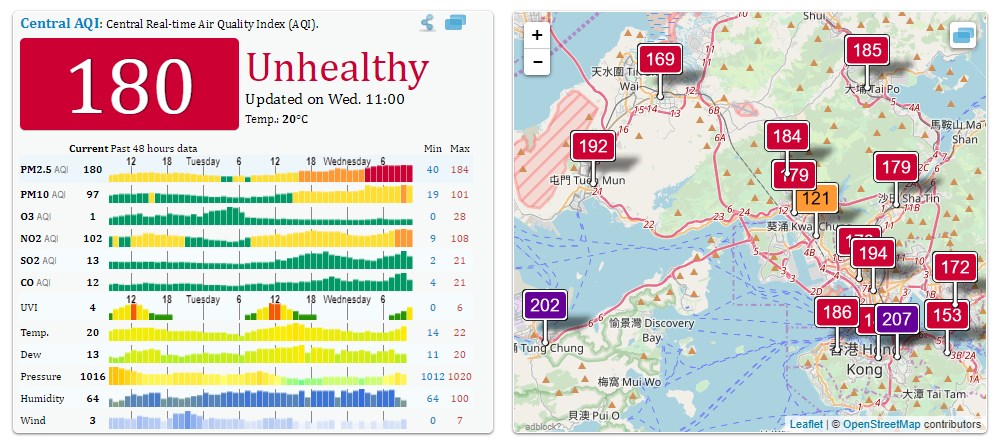The Environmental Protection Department has forecast a “moderate to very high” health risk as air pollution in the city reached “unhealthy” levels on Wednesday.
The department recorded a “very high” health risk level of eight in Central and Western district on Wednesday morning. The government’s Air Quality Health Index also recorded level eight ratings at general stations in Tsuen Wan and Tung Chung, while levels reached nine in Kwun Tong and Tuen Mun. Roadside stations reached level 10 in Causeway Bay, and level nine in Central and Mong Kok.

As of 11am, the real-time air quality index site aqicn.org said that AQI levels in Central had reached 180 for PM2.5 particles microscopic particles harmful to human health – a level it categorises as unhealthy. The site also recorded “very unhealthy” AQI levels of 207 in Causeway Bay and 266 in Shenzhen.

The Environmental Protection Department said on Tuesday that the air quality health index levels had reached seven or above on 44 days last year.
Roadside stations reached level seven on 55 days last year whilst the number of high pollution days increased significantly from 2016 levels. In 2016, there were 26 high risk days at general stations and 31 days at roadside stations.
The department said the pollutant that saw the biggest increase in concentration was ozone, which increased by 31 percent at general stations and by 21 percent at roadside stations from the previous year. Nitrogen dioxide levels at roadside stations also rose by five percent.

According to Ming Pao, Dave Ho Tak-yin, the EPD’s Assistant Director (Air Policy) said that the concentration of ozone is easily affected by weather. He said that weather conditions conducive to the increase of ozone such as sunshine, high temperatures, and dry weather often occurred last year. He added that the presence of ozone also causes the nitrogen monoxide generated by cars to be converted to nitrogen dioxide, thus causing the increase.
According to the government’s Centre for Health Protection, ozone can provoke asthma attacks in people with asthma, and can also increase susceptibility to respiratory infection and aggravate pre-existing respiratory illnesses. Nitrogen dioxide aggravates existing chronic respiratory diseases, and long-term exposure can lower lung function and resistance to respiratory infections.
Hong Kong’s smog and fog this morning did more to make the city look mysterious than any filter ever could. pic.twitter.com/cl5u6COB5Z
— Andrew Leyden (@PenguinSix) January 17, 2018
Emily Cheng Yin-yin, Senior Environmental Protection Officer (Air Science), said there were many days last year where Hong Kong was affected by Northwest winds bringing pollutants from the Pearl River Delta, which also affected the city’s air quality.
The EPD forecasts that the health risk for Thursday will be low to moderate at general air monitoring stations and moderate at roadside stations.
